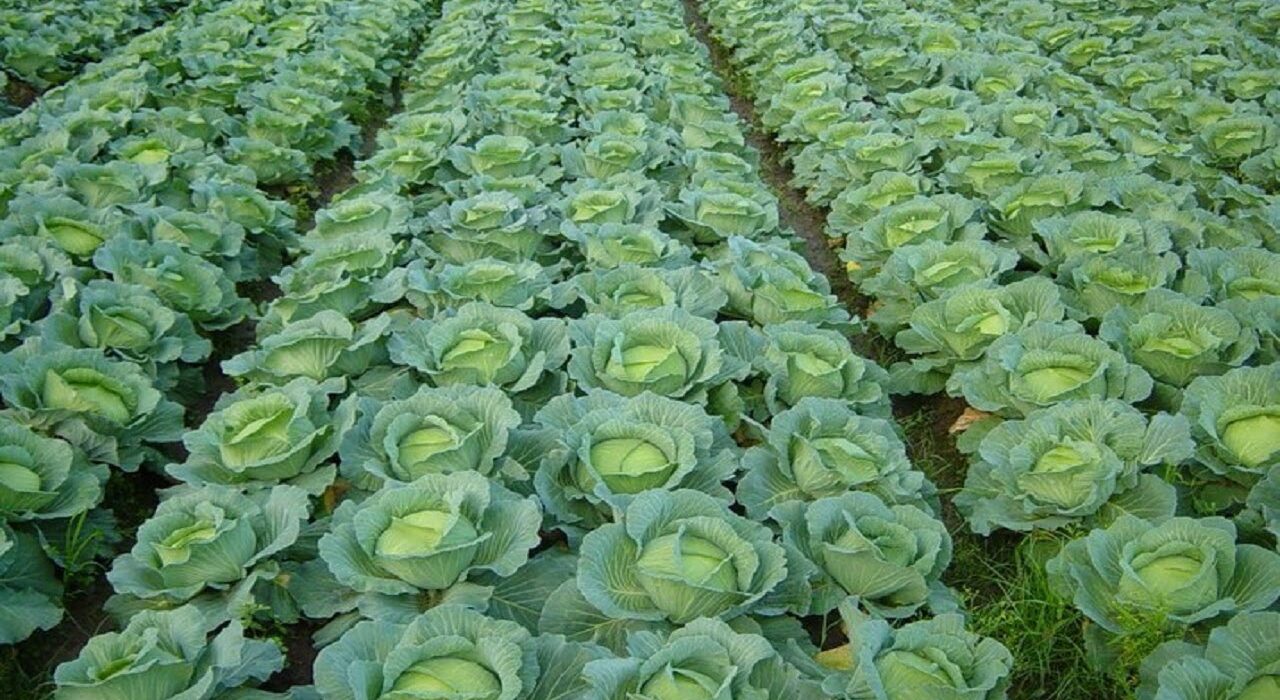Cabbage farming in Kenya has steadily gained popularity among both smallholder and large-scale farmers. This leafy green vegetable is not only a staple in local diets but also has great economic potential due to its wide market demand. With the right farming practices, cabbage farming can become a highly profitable venture in Kenya’s agricultural sector. In this article, we will explore essential details about cabbage farming, including the best ecological conditions, planting methods, pest control, and market opportunities. We’ll also provide insights into how farmers can maximize their profits through efficient farming practices.
Ideal Conditions for Cabbage Farming in Kenya
To grow healthy and high-yielding cabbage crops, certain ecological factors need to be carefully considered. These include soil conditions, rainfall patterns, temperature, and altitude, which all play a significant role in determining the success of a cabbage farm. The following conditions are ideal for cabbage cultivation in Kenya:
1. Soil Conditions
Cabbages thrive in soils that are rich in organic matter, providing necessary nutrients for robust growth. The soil should have a pH level ranging from 6.0 to 6.5 to ensure proper nutrient uptake. In addition, the soil should be well-drained to avoid waterlogging, which can damage the cabbage roots and hinder growth. Adding organic fertilizers such as compost and farmyard manure can significantly improve soil fertility and structure, promoting better cabbage development.
2. Rainfall Requirements
Cabbages require consistent moisture to grow well. Ideally, the crops should be grown in areas that receive between 500mm to 1,000mm of rainfall annually, with evenly distributed rainfall throughout the year. During dry seasons, farmers in Kenya may need to rely on irrigation to supplement natural rainfall and ensure the cabbage plants receive enough water.
3. Altitude and Temperature
Cabbages are cool-season crops, making them well-suited for regions with moderate temperatures. The ideal altitude for cabbage farming ranges from 700 to 2200 meters above sea level. This altitude range is found in many highland areas of Kenya, including Central Kenya, Rift Valley, and Western Kenya. Cabbage grows best within a temperature range of 16°C to 20°C, which is common in these areas. At these temperatures, cabbage heads form tightly and develop a firm texture, which is highly desirable in the market.
Seed Propagation and Planting Techniques
Cabbage farming can be done using seeds, either by direct sowing or through transplanting. While direct sowing is possible, transplanting seedlings from a nursery is often the preferred method, as it gives the cabbage plants a better chance to establish healthy roots. Here’s how you can go about propagating and planting cabbage in Kenya:
1. Propagation through Seedlings
Cabbage seeds are typically sown in nurseries where they can be nurtured for a few weeks before being transplanted into the main field. Transplanting allows for better control of the growing conditions, including temperature, moisture, and pest management. When seedlings reach a height of 10-12 cm, they are ready for transplanting into the field.
2. Proper Spacing for Healthy Growth
The spacing between cabbage plants is crucial for optimal growth. Different varieties of cabbage require different spacing:
- Large-headed varieties: 60cm by 60cm
- Medium-sized varieties: 60cm by 45cm
- Small-headed varieties: 40cm by 30cm
Adequate spacing between plants ensures that each cabbage has enough room to grow, receive sufficient light, and access the nutrients in the soil. This results in better yields and larger heads.
3. Fertilization for Maximum Yield
To promote strong cabbage growth, proper fertilization is essential. Farmers are advised to use Diammonium Phosphate (DAP) as a fertilizer at a rate of 75kg per acre. In addition, adding organic fertilizers like farmyard manure and compost can improve soil health and nutrient availability, leading to healthier cabbage plants.
Weed Management
Weeding is crucial for cabbage farming to prevent competition for nutrients, water, and light. Weeds can also harbor pests and diseases that can negatively impact cabbage crops. Early weeding is necessary to control weed growth before they become established. Regular weeding throughout the growing season ensures that the cabbage plants have optimal access to resources.
Weed control methods include:
- Manual weeding: Using hoes or hand tools to remove weeds from the soil.
- Mechanical weeding: For larger farms, machines may be used for more efficient weeding.
- Mulching: Applying organic mulch around the base of cabbage plants helps suppress weeds and retains moisture.
Pest and Disease Control in Cabbage Farming
Like many other crops, cabbage is vulnerable to various pests and diseases. Proper pest management is essential to protect the cabbage from significant losses. The most common pests and diseases affecting cabbage include:
Common Pests:
- Aphids: These insects suck sap from the cabbage leaves, causing wilting and stunted growth.
- Sawfly Larvae: Sawflies feed on cabbage leaves, creating holes and damaging the plant’s structure.
- Diamondback Moth: The larvae of this moth feed on cabbage leaves, leading to leaf loss and reduced photosynthesis.
Farmers can use a range of strategies to control these pests, including applying organic pesticides like neem oil, introducing beneficial insects such as ladybugs, and using insecticidal soap to target pests without harming the cabbage plants.
Common Diseases:
- Black Rot: This bacterial disease causes yellowing of leaves and wilting. It spreads rapidly and can devastate a cabbage crop if not controlled.
- Fungal Spots: Fungal infections can cause discoloration and lesions on cabbage leaves.
- Bacterial Soft Rot: This disease causes the cabbage heads to become soft and waterlogged, making them unfit for sale.
To manage diseases, farmers should use disease-resistant cabbage varieties and adopt good field hygiene practices. Crop rotation, where cabbage is alternated with other crops, can also help reduce the spread of soil-borne pathogens.
Harvesting Cabbages
Cabbages are typically ready for harvest 3 to 4 months after transplanting, depending on the variety and growing conditions. Harvesting should be done when the cabbage heads are firm and tightly packed. To avoid cracking, it’s best to harvest cabbage in the morning when temperatures are still cool.
Yield Expectations
An acre of well-managed cabbage farm can yield between 10,000 and 15,000 cabbage heads. The yield depends on factors such as plant variety, soil fertility, and pest management.
Marketing Cabbage in Kenya
Cabbage has a strong market demand in Kenya, thanks to its nutritional benefits and versatility in local cuisines. The demand for cabbage remains high throughout the year, with the vegetable being consumed by households, restaurants, and supermarkets. In addition, the cabbage farming market in Kenya is expanding, especially in urban areas where the population continues to grow.
Farmers can sell their cabbage in various markets, including:
- Local Open-Air Markets: A significant percentage of cabbage is sold in local markets, where small-scale farmers can reach consumers directly.
- Supermarkets and Groceries: With the increasing demand for packaged fresh produce, supermarkets are becoming a significant market for cabbage.
- Hotels and Restaurants: Cabbages are used in preparing salads, stews, and other dishes in eateries.
- Export: There is potential to export cabbage to neighboring countries or regions, especially with the growing demand for fresh vegetables globally.
The price of cabbage varies depending on size, quality, and market conditions. Prices tend to be higher during periods of low supply, such as during the dry season, and lower during peak harvesting seasons when supply is abundant.
Challenges in Cabbage Farming and Solutions
Cabbage farming, like any other agricultural venture, has its challenges. These include:
- Climate Variability: Unpredictable rainfall and fluctuating temperatures can affect cabbage yields. Irrigation systems and climate-smart farming techniques such as mulching and shade nets can mitigate some of these challenges.
- Pest Infestation: Pests such as aphids and cabbage worms can damage crops. Integrated pest management (IPM) practices, such as using natural predators, biological control agents, and organic pesticides, can help control pest populations.
- Market Instability: Prices for cabbage can fluctuate, affecting farmer profits. To manage this, farmers can diversify their produce, enter into contracts with supermarkets or wholesalers, and explore value addition (e.g., processing cabbage into dried or pickled products).
Cabbage farming in Kenya is a promising business for farmers looking for a high-demand, low-investment crop with significant returns. By understanding the ideal growing conditions, adopting best farming practices, and effectively managing pests and diseases, farmers can achieve high yields and profits from cabbage farming. As the demand for cabbage continues to rise in both local and export markets, the opportunity for farmers to grow and sell cabbage is more promising than ever.





